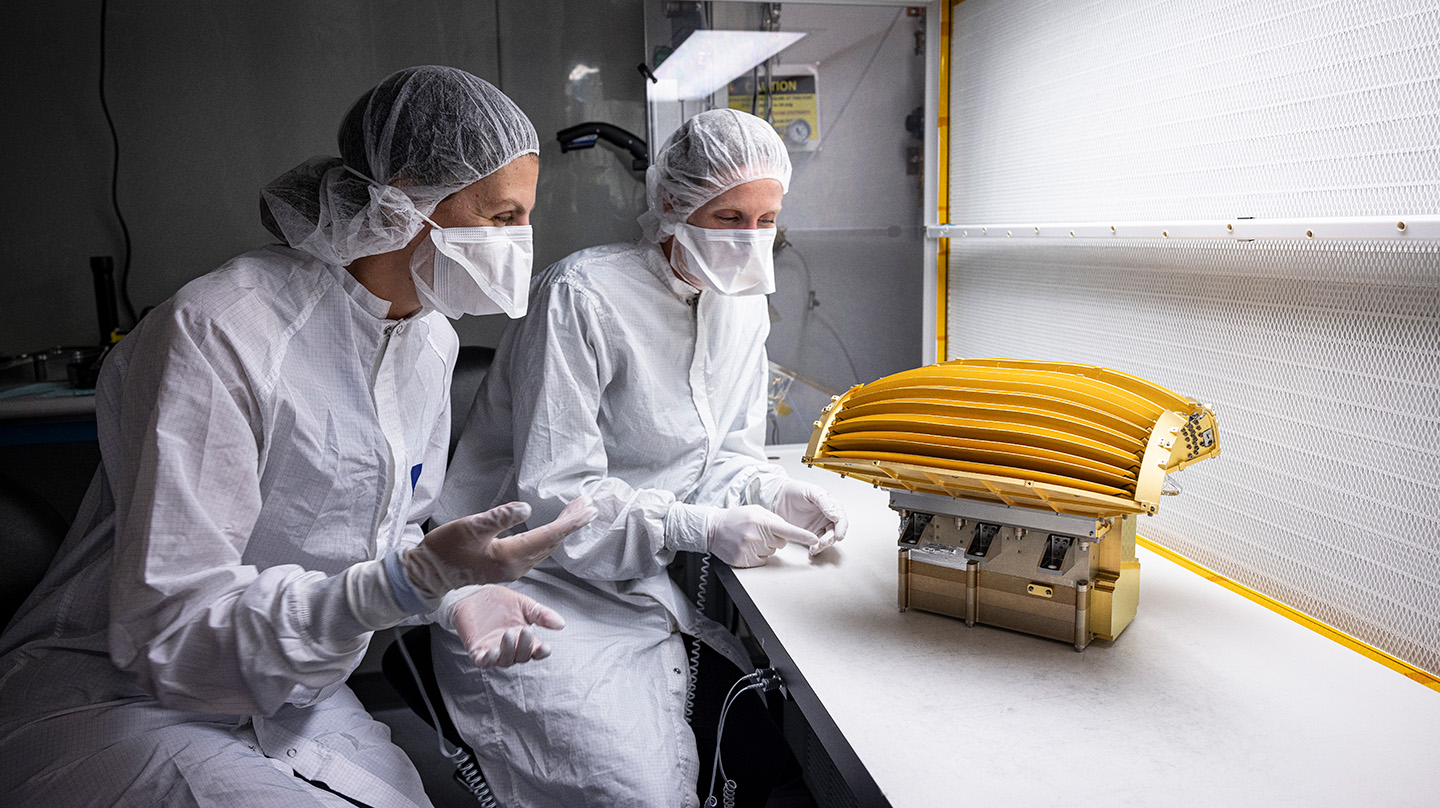Press Release
Johns Hopkins APL Team Readies Advanced Imager for Integration Onto NASA’s Interstellar Mapping and Acceleration Probe
Another instrument planned for flight aboard NASA’s Interstellar Mapping and Acceleration Probe (IMAP) is ready for installation on the spacecraft.
IMAP-Ultra is one of 10 instruments contributed from across 25 partner institutions on the Princeton-led IMAP mission set to launch in 2025, and the third instrument to be delivered for integration. IMAP-Ultra, a particle imager capable of capturing energetic neutral atoms (ENAs), particularly hydrogen atoms, made a short trip between clean rooms on the campus of the Johns Hopkins Applied Physics Laboratory (APL) in Laurel, Maryland, as part of IMAP’s integration and testing campaign.
Engineers will now perform a series of tests to ensure Ultra can properly communicate with the spacecraft before it is fully integrated onto the IMAP structure and into the onboard electronics system.
“We’re thrilled to reach this phase in IMAP Ultra’s development,” said Matina Gkioulidou, project scientist for IMAP and instrument lead for Ultra at APL. “Ultra will help the IMAP mission provide a more complete understanding of how energetic particles from the Sun influence the interactions of our solar system boundary with the local interstellar medium.”
The IMAP mission will observe the effects of the Sun’s activity throughout our extensive solar “neighborhood,” decoding the messages in particles from the Sun that speed past Earth, into deep space and even beyond our solar system. Like a modern-day celestial cartographer, the mission will map the boundaries of the heliosphere — the electromagnetic bubble surrounding the Sun and planets that is inflated by the solar wind.
IMAP will also investigate and chart the vast range of particles in interplanetary space, helping to investigate how charged particles from the Sun are energized and how the solar wind interacts with interstellar space at the solar system’s boundary.
“The Ultra team delivered a high-quality instrument that will play a vital role in the IMAP mission,” said John Scherrer, project manager for IMAP.
A livestream of the clean room at APL, where the spacecraft is currently undergoing integration and testing, is available on the IMAP mission website. Viewers can watch the stream at any time to witness the various stages of spacecraft assembly.
What Does IMAP Ultra Do?
Ultra is one of three imagers on IMAP capturing ENAs traveling from the boundary of our solar system. When charged particles from the solar wind reach our outer heliosphere, they interact with interstellar neutral particles and transform into ENAs. ENAs still retain information of the original charged particles, but losing their charge allows them to travel through space unbounded by the Sun’s magnetic field, and eventually reach the IMAP spacecraft.
IMAP’s three imagers will capture data on ENAs at varying energy levels. “Ultra will focus on ENAs at their highest energies, which allows us to probe shapes of the heliosphere and different time scales associated with the evolution of the heliospheric boundary,” said George Clark, deputy instrument lead for Ultra at APL.
Ultra is a direct descendant of the APL-built Jovian Energetic Neutrals and Ions (JENI) instrument on the European Space Agency’s Jupiter Icy Moons Explorer mission which launched toward the giant gas planet in 2023.
IMAP will sit at the first Lagrange point, known as L1, a position in space providing an uninterrupted view of the Sun. Because the radiation environment is less harsh than what it would face in Jupiter’s magnetosphere, Ultra has been made of different materials than JENI.
“We could decrease the weight since we didn’t have to shield the instrument from radiation like JENI faces at Jupiter,” said Gkioulidou.
Ultra also features unique gold-plated blades that deflect any charged particles, allowing only the neutral atoms to reach the instrument’s sensor.
Gkioulidou previously worked as co-investigator on the Radiation Belt Storm Probes Ion Composition Experiment used aboard the Van Allen Probes, which conducted the most in-depth exploration yet of Earth’s radiation belts. After working on JENI as co-investigator and deputy instrument scientist, she joined the IMAP team.
As instrument lead, Gkioulidou said the experience of guiding Ultra through all phases of its development has been “amazing.”
“It’s not one person’s success,” she said. “It takes a team of experts in a range of specialties to make these instruments successful.”
Princeton University professor David J. McComas leads the IMAP mission with an international team of 25 partner institutions. The Johns Hopkins Applied Physics Laboratory in Laurel, Maryland, builds the spacecraft and operates the mission. IMAP is the fifth mission in NASA’s Solar Terrestrial Probes (STP) Program portfolio. The Explorers and Heliophysics Project Division at NASA’s Goddard Space Flight Center in Greenbelt, Maryland, manages the STP Program for the agency’s Heliophysics Division of NASA’s Science Mission Directorate.
